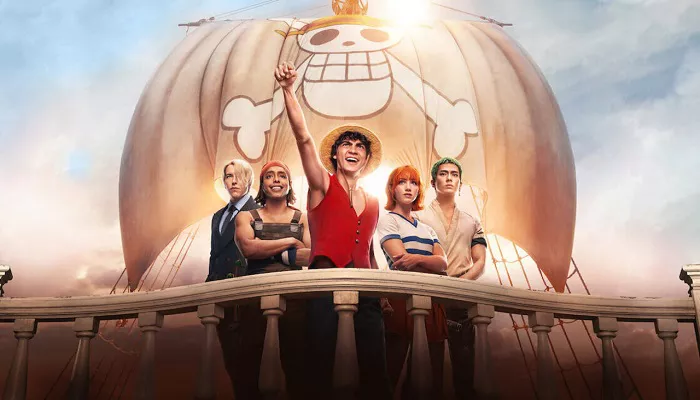For decades, One Piece has reigned as a titan of anime and manga, weaving a tale of pirates, dreams, and friendship that spans over 1,000 episodes. Yet its arrival on Netflix—via both the live-action adaptation and anime catalog—has sparked debate. Is this streaming debut a faithful homage or a diluted cash grab? Does it honor Eiichiro Oda’s vision or cater to algorithm-driven trends? This article dissects One Piece’s Netflix era, exploring its creative choices, cultural resonance, and whether it captures the soul of the Grand Line.
The Live-Action Leap Ambition Meets Reality
Netflix’s live-action One Piece faced skepticism from day one. Anime adaptations have a notorious track record, but showrunner Matt Owens prioritized collaboration with Oda himself, integrating the creator’s feedback into every script and design. The result is a series that balances Western storytelling pacing with Japanese aesthetic sensibilities. Vibrant set designs, from the Going Merry’s cozy deck to Shells Town’s oppressive naval base, mirror the anime’s whimsy without veering into camp.
The show’s commitment to practical effects over green screens grounds its fantastical elements—Luffy’s stretching limbs, crafted with hybrid CGI and prosthetics, feel tangible rather than cartoonish. Even the Sea King’s scaled menace, though less fluid than its anime counterpart, avoids the uncanny valley plaguing many fantasy adaptations.
Casting the Straw Hats Nailing the Vibe
Casting East Blue’s iconic crew was a make-or-break task. Iñaki Godoy’s Luffy radiates infectious optimism, capturing the character’s childlike joy and steel resolve. His rubber-limbed physicality, from slingshot punches to spaghetti-slurping antics, embodies the manga’s slapstick sincerity. Emily Rudd’s Nami balances sharp wit with guarded vulnerability, her eyes flashing with trauma beneath a thief’s smirk. Mackenyu’s Zoro delivers stoic intensity with subtle humor, wielding three swords with the precision of a samurai and the swagger of a brawler. Jacob Romero’s Usopp leans into the character’s comedic cowardice, while Taz Skylar’s Sanji simmers with unspoken tragedy beneath his flirtatious charm.
The chemistry among the cast mirrors the manga’s found-family theme, though some purists argue the script softens darker edges—like Nami’s enslavement or Sanji’s starvation—to appeal to broader audiences.
Pacing and Arcs Condensing the Uncondensable
The first season adapts the East Blue saga—roughly 45 anime episodes—into eight hour-long episodes. Key moments like Arlong Park’s emotional climax retain their weight, with Nami’s tearful plea (“Help me!”) echoing the anime’s raw despair. Subplots like Usopp’s Syrup Village arc, however, are trimmed to bare bones, reducing Kaya and Klahadore’s layered dynamic to a footnote.
This compression sharpens the narrative for newcomers but sacrifices character nuance. The Baratie arc thrives under tighter pacing, though, highlighting Sanji’s moral code and Zeff’s paternal gruffness. The decision to merge Loguetown’s introduction with season one’s finale adds momentum, teasing Smoker’s arrival without bogging down in setup.
Visual Language Anime in Live-Action Clothing
Cinematographer Nicole Whitaker infuses the series with anime-inspired framing—dynamic angles, exaggerated close-ups, and pauses for dramatic effect. Fight scenes, particularly Zoro’s three-sword battles, blend choreography with CGI flair. The “Dracule Mihawk” duel, a downpour of clashing steel and swirling capes, channels the manga’s kinetic energy.
The show’s color palette pops with cartoonish brightness—Orange Town’s carnival hues contrast with Baratie’s golden warmth—though some CGI creatures (notably the Sea King) lack the anime’s fluid menace. Costume design walks a tightrope between practicality and flair; Buggy the Clown’s patchwork absurdity and Mihawk’s gothic elegance feel lifted from Oda’s sketchbook.
The Anime Catalog A Gateway to the Grand Line
Netflix’s anime library offers curated One Piece arcs, from the iconic Alabasta saga to Water 7. While not exhaustive, these selections provide entry points for casual viewers. The platform’s inconsistent episode availability, however, frustrates long-time fans—key arcs like Enies Lobby vanish and reappear without warning. Dubbed and subbed options cater to global audiences, though purists argue the English dub’s tone sometimes misrepresents character dynamics.
Luffy’s dubbed voice, for instance, lacks the original’s gravelly mischief, flattening his chaotic charm. Still, the catalog’s HD remastering breathes new life into early 2000s animation, sharpening the vibrancy of Skypiea’s golden skies and Drum Island’s snowbound drama.
Cultural Bridges and Missed Opportunities
The live-action series avoids the “whitewashing” pitfalls of past adaptations by embracing diversity. Cocoyasi Village’s casting reflects the manga’s multicultural ethos, with actors of South Asian and Indigenous heritage embodying the island’s oppressed fishermen. Arlong’s fish-men design balances grotesque realism with social commentary—their gnarled fins and sun-bleached scales evoke both maritime myth and marginalized communities.
Yet the show shies away from the source material’s political grit. Arlong’s systemic exploitation is framed as personal vengeance, sidestepping the manga’s critique of institutional racism. Similarly, the World Government’s corruption is hinted at but never explored, sanding down the story’s revolutionary edges for a PG-13 tone.
Fan Reception Divided Seas
Reactions split between praise for its heart and critiques of its compromises. Anime loyalists lament omitted details—Luffy’s signature sandals replaced by boots, Zoro’s iconic headband absent in key scenes. Others applaud the show’s accessibility, with condensed arcs serving as a gateway for newcomers.
The series’ global Top 10 ranking proves its mainstream appeal, but whether it converts viewers into lifelong fans remains debated. Social media buzz reveals split camps: TikTok edits celebrate Godoy’s Luffy as “perfect casting,” while Reddit threads dissect pacing missteps. Even Oda’s endorsement—“I felt like I was watching the real Straw Hats”—fails to quell all doubts.
Conclusion
One Piece on Netflix is neither a flawless gem nor a fool’s gold. It’s a spirited attempt to translate an unwieldy epic into digestible entertainment, prioritizing emotion over encyclopedic accuracy. The live-action’s triumphs—its cast chemistry, visual boldness, and reverence for Oda’s spirit—outweigh its stumbles. As for the anime catalog, it’s a worthy primer, though no substitute for the full voyage. For now, Netflix’s One Piece is a treasure chest with a few missing doubloons—valuable, but not the whole hoard. As Luffy would say, “It’s not about what’s in the chest… It’s about the adventure!” And this one’s just begun.


